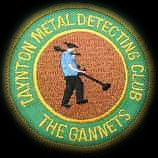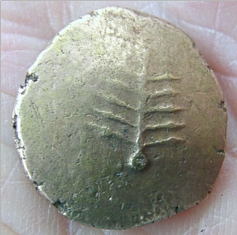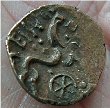
History of Taynton
Parish History
The Dobunni
Roman Iron Making
Roman mosaic
Taynton Parva
St Lawrence Church
Glass Making
Brick Yard & Pottery
Brass Mill
WWII
Typhoon Crash
Hampden Crash
US Camp
US Finds
Taynton Metal Detecting Club
The Gannets
The Dobunni
The Dobunni were one of the Celtic tribes living in the British Islands prior to the Roman invasion of Britain.


Dobunni Stater
The coin above was found by club member Mike Christie at Dymock, Gloucestershire in 2006 and is inscribed EISVG. It is of the tribal leader Eisvrig and is thought to date from c AD20 to c AD43. It has a gold outer with a copper core and would have been in circulation when the Romans invaded in AD 43.
Dobunni coinage has the distinctive motif of a three-tailed horse and a chariot wheel on the reverse side and on the obverse side a tree-like symbol probably representing fertility. It may represent an ear of Emma wheat, a very important crop and a variety believed to have been bred by the Celts.
Evidence gained from plotting coin distribution shows that the Dobunnic territory extended from the Upper Thames Valley, across Gloucestershire into Somerset and northern Wiltshire. The Dobunni were a large group of farmers and craftsmen, living in small villages concentrated in fertile valleys. They were one of the few tribes known to issue coins before Roman arrival. They submitted to the Romans even before they reached their lands and adopted the Roman lifestyle. Their capital acquired the Roman name of Corinium Dobunnorum, known today as Cirencester. Eisvrig was quite likely to have been the leader who surrendered to Plautius during the Roman invasion.